

 |
 |
Having to start cataloging my collection I
have established a pattern with a series of text fields that
can best describe a miniature bottle as a whole.
On this page I have included detailed descriptions of the fields
in the various sections (Whisky, Rum, etc..)
the list may be of help to any collector who is preparing to
catalog your collection.
With this scheme I have to admit it was a great job cataloging my
collection,
and it is for this reason that it is possible to adapt the scheme
to their needs, simplifying and
eliminating many descriptive fields, because since this is the
photo of the miniature, the same
makes some unnecessary data description.
is thus possible to use a simplified model of this type,
certainly less heavy and
easier to use:
| Main picture | Product | Producer | Country | Capacity | Gradation |
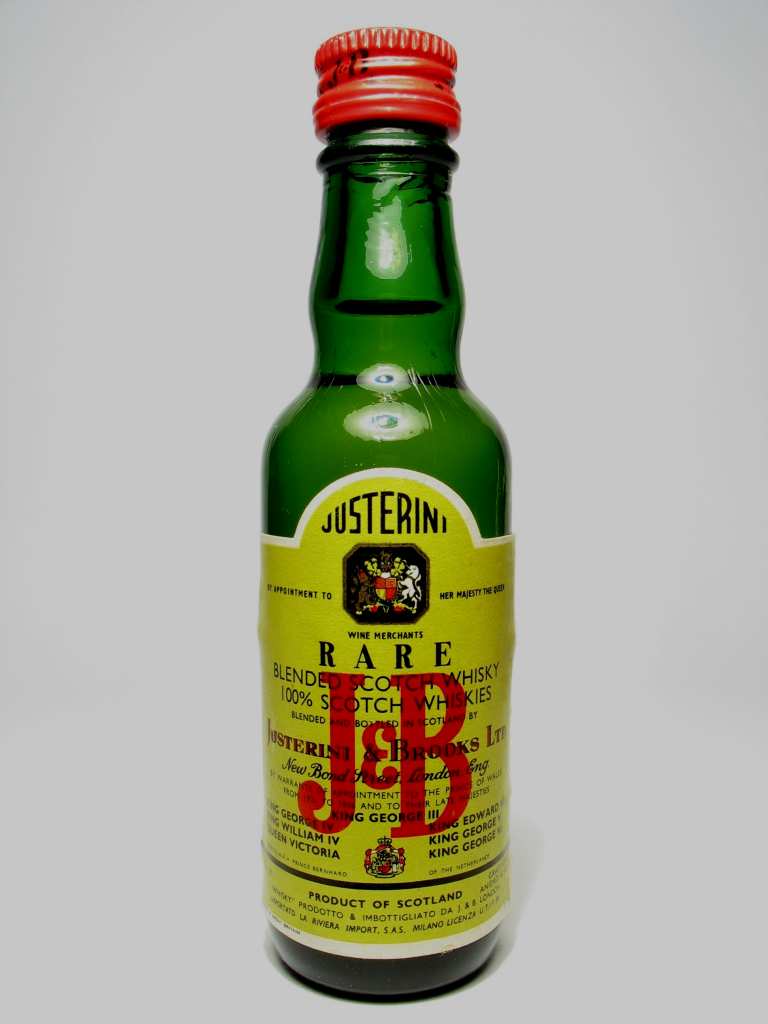 |
J & B Rare | Justerini & Brooks Ltd. - New
Bond Street, London, Eng. |
Regno Unito | CL. 3.7 | Gradi 43% |
This however is the pattern that I made:
Product
Producer
Country
Importer
Container
Form
Height
Closing
Label
Capacity
Gradation
License
Tax
Period
Estimate
Notes
Main picture
Secondary Image
Fields not included:
Conservation
Disposal
The fields can thus be divided in a logical manner:
Identification data (identifying the product, the
Manufacturing company and country of origin):
product
producer
country
importer
Descriptive data (describing the miniature as a whole):
container
form
height
closing
label
capacity
gradation
Fiscal data (including license and excise duty):
license
tax
Assessment data (they give a value to mignon):
period
Storage (this field has not been entered)
estimate
Additional data (including generic data of different
types):
Disposal (this field has not been entered)
Notes
Image paths (including the two fields available for
images combined with mignon):
main picture
Secondary image
Detailed description
of the fields:
Product
In the "Product" is added to the name
of the liquor, possibly accompanied by
name of the company (eg. "Stock 84 Brandy").
Producer
The "Producer" includes the name of
the company or liquor distillery.
If present, I have also included the location, and in this way it
is possible to know the
origin of mignon.
Country
In the "Country" I specified the
country where it was produced mignon.
If it is a miniature Italian manufactured under license by a
foreign company, I have specified the Country
foreign country where it was produced.
Some liquors esters can be produced in a given country and
bottled in another
(as in the case of some Canadian Whisky distilled in Canada and
bottled in the United States); in this case
I specified two countries, eg. "Canada - United
States."
Importer
For "Importer" means the company
import / export marketing a certain mignon in Italy.
The words of the importer may be present with a label to part (perhaps
on the back of mignon),
or you can find printed on the main label.
But there are also foreign mignon that have no words, perhaps
because imported
with few or parallel imports.
How to recognize these mignon?
If the foreign mignon does not have any words but has the mark
state tax on consumption,
is considered to be imported and in the field I typed "Not
given."
If mignon does not have the words nor the importer nor the band
of Mark of State, it is likely that
is "original", that is purchased in the country of
origin.
I specified the importer for the Italian mignon produced for the
export market and imported from Firms
import / export foreign, or foreign mignon produced for countries
other than Italy.
(Eg. Mignon of a Scotch Whisky produced in Scotland and imported
in the U.S.).
Container - some examples:
Clear glass white
Transparent glass green
Brown glass
Frosted white
Frosted glass green
Brown frosted glass
Opaline glass
Opaque glass (color)
Enamelled glass (color)
Blown glass (color)
Clear plastic white
Clear plastic green
Clear plastic brown
Plastic White Satin
Plastic green satin
Plastic matt brown
Plastic non-transparent (color)
Ceramics (color)
Terracotta (color)
For "Container" means any material
with which is made the mignon which can be, as the larger of
cases, glass, or plastic, ceramics, pottery, etc..
The description also includes the type of processing, that is
transparent, satin, etc..
and finally, the color of the material.
A few examples:
For "Glass opal" means a type of glass
not transparent milk-white color,
for "enamelled glass (color)" refers
to a painted glass (I specified instead of "color"
the color of the glaze).
Blown glass is a type of very thin glass recognizable by the
typical "sound", this is usually
containers of artistic handmade.
For glass and plastic non-transparent means a glass, generally, a
black or very dark brown.
(Typically some mignon Sherry).
Form - some examples:
Rounded
Rounded shaped
Rounded bulbous
Rounded cylindrical
Flat
Flat rounded
Flat shaped
Oval
Tonda
Triangular
Square
Rectangular
Pentagonal
Hexagonal
Octagonal
Faceted
Pocket
Flask
Shaped
In this field I have included the shape of the container mignon,
here are some examples:
for "Rounded" means the classical form,
typical of a bottle, without special features,
"Rounded shaped" mignon rounded with a
particular shape of the glass, "Rounded bellied"
a
bottle rounded wider at the bottom, "Rounded
cylindrical" a miniature-shaped cylinder
usually with no neck.
Form a "Flat" refers to a miniature
crushed, while a "Flat rounded" a
cross between a
crushed bottle and a rounded, "Flat shaped"
a substantially flat mignon with particular
shape of the glass, "Oval" and "Round"
of bottles spherical.
For the types "Triangular", "Square",
"Rectangular", "Pentagonal",
"Hexagonal" and "Octagonal"
means the
shape of the base of the mignon, while "Faceted"
a mignon with more than eight sides.
For mignon "Pocket" is the classic
mignon (usually 10 cl of content) with cap-shaped
glass, by a substantially flat, the "flask"
instead is a mignon which reminds
in the form of a bottle of wine.
For mignon "Shaped" means a bottle
with a particular shape that represents eg. an animal,
an object, character, etc.. In this case, I added the shape of
miniature in his appearance.)
If a particular liquor is recognizable by the particular shape of
the bottle, I have specified the adjective "typical"
eg. the bottle of brandy Vecchia Romagna has a characteristic
shape, in this case the
product is recognizable by its triangular shape of the bottle,
then it is a form "typical"
(In this case "Triangular typical").
The description of the shape may include other adjectives such as
eg. "High", "Low" or "Short neck"
"Long Neck", etc..
If the bottle has the recessed bottom upwards, the specified I
inputting, eg. "Fund hollow."
Height
In the "Height" I put the total height
of mignon in centimeters (eg. 10, 11.5, etc..).
Normally the picture combined with mignon may mislead the actual
size of a bottle,
especially when you take a picture almost completely filling the
area above
and bottom of the image.
In this case both a miniature high 10 cm high mignon that a few
cm appear the same size.
The "height" allows you to get an idea
of ??the size of the miniature described.
Closing - some examples with pictures to clarify the best
type of closure:
Metal cap screw:
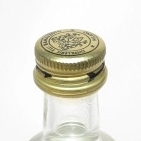
Metal cap-off:
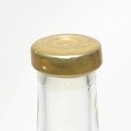
Metal cap-off with one tongue:
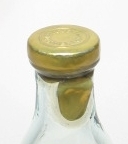
Metal cap-off with two tongues:
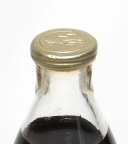
Plastic cap screw:
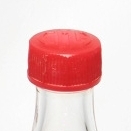
Plastic plug in snatch:
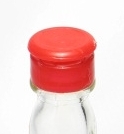
Plastic cap pull-tongue:
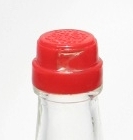
Cork:
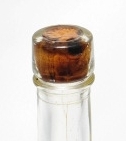
Cork with metal cover:

Cork stopper with plastic coating:

Cork with aluminum foil:
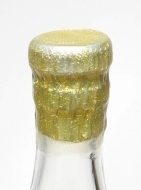
Cork with wax:

Cap clips:

Crown cap:
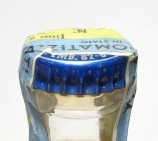
For "closure" is
meant the type of cap of the bottle.
Through the cap is also possible to identify the production
period; in general the metal plugs in
tear for the years 60/70, plastic cover for the '70 / '80, plugs
of metal screw from the 80s to the
day, while the cork, mignon '60s / '60s antecedents,
but in this field there are many exceptions (such as the majority
of whiskey
Americans of the '30s, '40s and '50s that have metal caps or
screw-off).
Some mignon may have a "cap top" eg. a
plastic cap placed over a
metal cap-off (this is typical of some miniature vintage).
In the description of the cap I put the color or colors.
The caps can then have the written and / or coats of arms screen
printed or embossed, in this case I
specified in the description (eg. "metal screw-cap
gold, with written" or
"Metal screw-cap gold, with arms raised").
Label - some examples:
Main
Main + collar
Main + bezel
Main + sticker
Main + back label
+ Back label main importer
Main + sub-label
Main + sub-label importer
The "Label", a key element in the
description of a miniature, contains all textual data such as
the capacity and gradation.
The above example contains only a fraction of all possible
combinations of labels
that the mignon can have.
In fact there are many types of label:
the label "Main" in many cases is the
only one on mignon, can contain all the data recognition
(Product name, company, capacity, gradation, etc..); May also be
present two labels
Main (first positioned at the top and second bottom) in this case
I
specified: "2 Main".
The "collar" is represented by a strip
of paper that wraps around the neck of the bottle immediately
below the
cap, the "bezel" is usually located
under the rim of the main label mignon and above and can identify
a type of liquor (eg. mignon in Cognac VSOP can be written, VS, 3
stars, etc..)
in the same position can be found, in place of the bezel, the "dot",
typically representing the crest
of Enterprises; the stamp can also be of sealing wax.
The "back label" is at the back of the
mignon and usually contains additional information on liquor,
but it can also be a "back label importer"
added by the company to import.
The "sub-label" and "sub-label
importer" are placed under the base of the mignon,
generally are
uncommon and belong to the mignon several years ago, they can
specify the capacity and gradation
if the main label does not possess.
In addition to these labels may be others types like bands
running vertically between the various labels
(Over that of paper can be of satin, canvas or screen printed
directly on the glass).
Some labels are tied to the neck of mignon with a string or a
rubber band.
Capacity
The "capacity" identifies the amount
of product that may contain a mignon, generally the capacity is
indicated
main label and is expressed eg. in Cl. (Cl), Ml. (Milliliters), L.
(L), etc..
On some Italian mignon period can be specified with the "g".
For some mignon produced in the U.S. is the ability in "Pint"
(eg. "1/10 Pint").
The letter "e" that appears on the label of many mignon
(eg. "3 cl. E") means that the capacity is in line with
standards of the EEC.
I have entered the data capacity exactly as found in the label.
Some mignon, especially vintage, do not have any words on the
label about the capacity in this
If I specify an approximate capacity in order to give an idea of
??the size of the miniature;
I inserted in the field, eg. "Not indicated (about 3
cl.)".
In case the label is not readable or torn at the point where the
capacity is indicated,
can be found, for example. "I do not read (about 3
cl.)"
Gradation
The "Gradation" alcoholic liquor or a
distillate, as in the case of capacity is, in general,
indicated on the label main.
And 'possible to find a variety of formats (eg. 40%, 40 Gr, 40 °,
etc.)..
I entered the data in the field as you have them on the label.
Some mignon, especially vintage, do not have any words on the
label about the strength,
In this case, the field will be found "not specified".
If the label is not readable or torn at the point where it is
indicated grading,
you can read eg. "I do not read."
In the previous examples the gradation is expressed in degrees GL
(Gay-Lussac) normally used in
Most countries, however, the gradation can also be expressed in
Proof. American or Proof. English;
following the table of correspondence between the percentage of
alcohol content, degrees GL and Proof.:
| % of alcol | Gay-Lussac | american Proof. | english Proof. |
| 10% | 10° | 20° | 17,50° |
| 20% | 20° | 40° | 35° |
| 30% | 30° | 60° | 52,50° |
| 40% | 40° | 80° | 70° |
| 41% | 41° | 82° | 71,75° |
| 42% | 42° | 84° | 73,50° |
| 43% | 43° | 86° | 75,25° |
| 44% | 44° | 88° | 77° |
| 45% | 45° | 90° | 78,75° |
| 50% | 50° | 100° | 87,50° |
| 57,14% | 57,14° | 114,28° | 100° |
| 60% | 60° | 120° | 105° |
| 70% | 70° | 140° | 122,50° |
| 80% | 80° | 160° | 140° |
| 90% | 90° | 180° | 157,50° |
| 100% | 100° | 200° | 175° |
License
The production license concerns mignon mignon Italian and foreign
imported, it is the
license U.T.I.F. (Technical Department of
Taxation Manufacturing).
Typically the license U.T.I.F. can be found on the label in this
format:
[License UTIF] [number] [city code or city]
eg. "Lic UTIF Ranked # 391 Genoa", you can
find, eg. also simply "Lic No. 14".
Since 1994 the license U.T.I.F. has become U.T.F.
eg. "Utf Lic Tn 114" or "UTF Lic At No. At A00061A"
etc.. (Hence the miniature bearing the inscription UTF were
produced after 1994).
Even more recently, the license U.T.F. has been replaced by the "Excise
Tax", so you can find
on the label, eg. "C. Acc IT00PEA00001E" or "Acc
Code 00019 Vi Q", etc..
Tax - some examples (the list is not definitive):
Excise duty on ethyl alcohol up to 5 cl
Excise duty on ethyl alcohol up to 0.10 l
Excise duty on intermediate products up to 0.10 l
Agave spirits to cl. 4
Agave spirits liters up to 1/10
Agave spirits up to 0.100 liters
Cane brandy to cl. 4
Cane brandy liters up to 1/10
Cane brandy up to 0.100 liters
Grain spirit to cl. 4
Grain spirit liters up to 1/10
Grain spirit up to 0.100 liters
Fruit spirit to cl. 4
Fruit spirit liters up to 1/10
Fruit spirit up to 0.100 liters
Brandy liters up to 1/10
Brandy aged more than three years until liters 1/10
Wine distillate liters up to 1/10
Not wine distillate aged up to cl. 4
Wine distillate aged from one to two years to cl. 4
Wine distillate aged from one to two years up to 0.100 liters
Wine distillate aged one to three years to cl. 4
Wine distillate aged over two to three years to cl. 4
Wine distillate aged more than three years to cl. 4
Wine distillate aged more than three years to l. 1/10
Wine distillate aged more than three years up to 0.100 liters
Extracts for liqueurs
Grappa to cl. 4
Grappa aged at least one year up to cl. 4
Grappa aged at least one year up to 0.100 liters
Grappa liters up to 1/10
Grappa up to 0.100 liters
Metal seal Monarchy with beams up to l 1/10
Metal seal with beams up to the Monarchy. 1/4
Metal seal Monarchy without tow up to l 1/10
Metal seal Monarchy without tow up to l. 1/4
Metal seal 1st Republic (head of a woman) to liters 1/10
Metal seal 1st Republic (head of a woman) to l. 1/4
Metal seal 2nd Republic (Star) to liters 1/10
Metal seal 2nd Republic (Star) to l. 1/4
Spirits to cl. 4
Spirits liters up to 1/10
Spirits up to 0.100 liters
Aromatized wines up to 0.100 liters
Aromatized wines up to 10 cl.
Liqueur wines up to 0.750 liters
To "Tax" means the mark state which
may be the band, the label or seal
applied metal mignon on Italian and foreign imported.
These marks have been many changes to adapt to various provisions
of the law
which came into force over the years.
For metal seals, I refer you to this particular article: Mignon with
Seal
The list above includes a set of labels and seals most common,
but you can find
other types of marking.
If mignon has a band or a label abroad, I have described, eg. for
mignon Whiskey
made in the USA you can find clips red / white or blue / white,
in addition to the label
specific state (eg. Maryland, Tennessee, etc.). mignon some
produced in Spain have a
vignette from 4 or 50 Centimos, etc..
Some foreign bands have the year of issue, in this case, I put in
the description.
If the miniature possesses marks (the Italian and foreign), I
specified both
inserting eg. first description of the Italian flag and then the
foreign market.
(Eg. "Brandy cereals liters up to 1/10 + clamp Use"
Export "red / white).
Period
To establish the "Period" of producing
a miniature, you can refer to different elements, such as
type of closure, licensing and the various types of tax.
Also the personal experience of the collector helps to put the
miniature in his time of production.
However, many mignon have the date of manufacture stamped on the
label, you can sometimes find
only the year of production, sometimes the complete date (day,
month, year).
The mignon which carry the date may be, eg. the numbered series
for collectors, some types of
mignon wine (generally report the year of harvest), miniature of
Scotch Whisky that can bring
is the date of distillation that the date of bottling, etc..
For all mignon that do not have a date, I set the time by
entering in a period
Approximate eg. "Years '60 / '70."
And 'possible to find the year of manufacture printed on the
glass under the root of many Italian mignon
produced in the '60s / '70s (eg. "10.63", "65",
etc.)..
Do not confuse the year with the numbers of the production line
that are equally
engraved under the base of the miniature.
Estimate - some examples:
*
* *
* * *
* * * *
* * * * *
For "Estimate" means the value of a
collectible miniature that must be assessed on the basis of
Some elements, such as the period, the state of preservation,
evaporation, and the rarity of mignon.
(Personally I put the aesthetics therefore my judgment should not
be taken in
considered to give an assessment of the miniature, but may be
indicative only).
Also the personal experience helps to give a fair value estimate
to a mignon.
Notes
In the "Notes" I put any kind of data
specific to a miniature that can not be
described in the previous fields, eg. if the mignon possesses a
box or is part of a package
(See Boxes and packaging),
if the miniature is evaporated
(See Avoid evaporation), or
if it has a particular band or
other characteristic of the described mignon.
if some mignon possess written on the glass, or marks, I have
included in the description
(Eg. Labeled "Stock embossed on the glass " or
" mark embossed on the glass ").
I also entered in this field defects as the miniature,
eg. label stained or torn.
I have also noted the degree of evaporation, eg. "Mignon
evaporated to 1/4" indicates a mignon with
a level of content that reaches approximately the area below the
neck of the bottle,
"Mignon evaporated for 2/4" a mignon
in which the level reaches the middle of the bottle,
"Mignon evaporated for 3/4" indicates
that the mignon is evaporated for more than half of the bottle,
Finally, "Mignon evaporated to 4/4" a
miniature empty.
Main picture
Secondary image
For each miniature I wanted to give the opportunity to combine
two images: one image
primary and secondary.
The 'picture may represent the back if mignon possesses a
backlabel interesting, or the box or packaging of mignon or even
a
particular of the bottle (eg. the metal seal, etc..).
Fields not included
I decided not to include these two fields as they are not of use
to those who consult the pages of the
my site, this is the state of conservation of the piece and the
provision of
mignon in the showcase.
These two fields are described, however, as they can be of help
to the collector:
Conservation - some examples:
Excellent
Good
Discreet
Low
Terrible
For "Conservation" means, overall, the
state in which there is a miniature, which can
be summarized from the above examples.
Some features contribute to the conservation status of a
miniature, such as age,
the level of the content and the label.
The judgment should also take into account the age of the mignon.
Disposal
The "Disposition" has a particular
function: it is used to find a specific
mignon in a cabinet, shelf or in a showcase.
In practice, this field is used to match a mignon relative to the
furniture sector that contains it.
Cataloging his collection of PC, the search for mignon is very
fast though
composed of thousands of pieces, the more difficult it is instead,
the search for a miniature within
maybe a piece of furniture, there are thousands of other mignon.
Before using this field I drew a map of the cabinet and I called
sectors
(Which may be eg. The shelves or the internal divisions of the
cabinet), with an abbreviation or a number.
Then when I insert data from a miniature set in a certain sector
of the mobile
I insert in the field also its abbreviation (eg. "Sector 15"
or eg. "SW-4" for Scotch Whisky, etc..).
In this way you can easily find the miniature within their
collection.
Name of the image file
For the names of the image files that are displayed on my site (photos
of Mignon) I used
a format identifier consists of a prefix followed by the number,
and possibly, if it is
a secondary image, a subsequent letter to the file number.
For example:
Prefix identifier with three letters (eg. Swb-)
Number of four spaces (eg. 0024)
Indication of secondary image (eg-S)
Examples:
SWB-0024
SWB-0024-S
In the catalog of PC will be easier to identify a miniature
belonging to a particular group
(Eg. Whether you are looking for a Blended Scotch Whisky mignon,
just find
all files that have the prefix SWB).